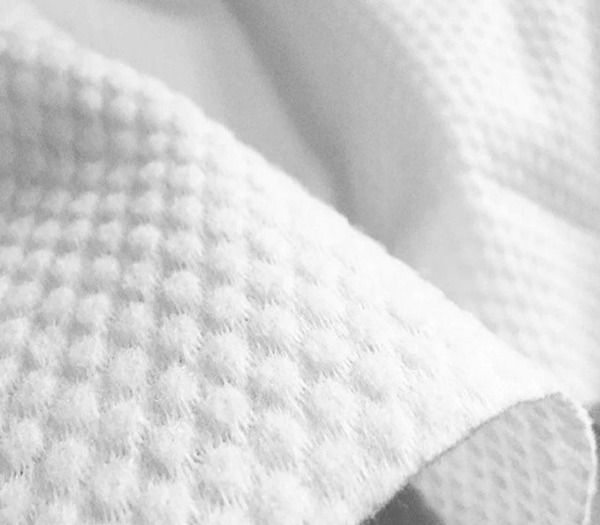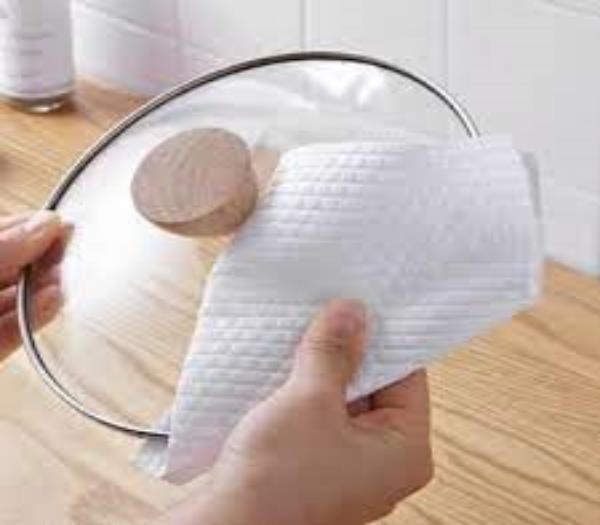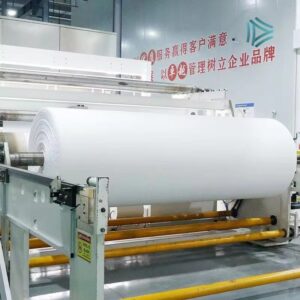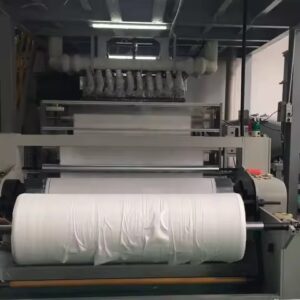Embossed Spunlace Nonwoven – Sustainability, Market Insights, and Future Trends
Introduction
This article is the second part of our in-depth series on embossed spunlace nonwoven. If you missed Part 1, start here: Technology, Properties, and Advantages of Embossed Spunlace Nonwoven
The global textile industry is under immense pressure to balance performance, cost, and environmental responsibility. With stricter environmental regulations, rising consumer awareness, and increasing raw material challenges, manufacturers are forced to innovate continuously. One material that embodies this balance is Embossed Spunlace Nonwoven—a fabric that combines the strength of hydroentanglement with the functionality and aesthetics of embossing.
Beyond its technical advantages, embossed spunlace nonwoven has become a benchmark for sustainable and market-driven innovation. Its ability to integrate biodegradable raw materials, efficient production processes, and value-added designs positions it as a leading solution for hygiene, healthcare, industrial, and lifestyle markets.
This article examines the sustainable practices, cost considerations, recycling approaches, design innovations, production challenges, and market outlook that shape the present and future of embossed spunlace nonwoven.
Eco-Friendly Production Practices
Sustainability is no longer optional—it is the foundation of modern nonwoven manufacturing. Embossed spunlace nonwoven integrates eco-conscious practices at every stage of production.
1. Environmentally Responsible Raw Materials
The choice of fiber is critical in determining both environmental impact and fabric performance. Manufacturers increasingly favor:
Viscose and cotton – Biodegradable and renewable resources.
PLA (polylactic acid) – Derived from corn starch, fully compostable.
Bamboo fibers – Naturally antibacterial and biodegradable.
Recycled polyester (rPET) – Gives new life to post-consumer plastics while reducing landfill waste.
Blending these fibers enables manufacturers to create fabrics that are not only high-performing but also aligned with circular economy principles.
2. Hydroentanglement Without Chemicals
The spunlace process uses high-pressure water jets rather than adhesives or binders. This means:
No chemical residues that could harm skin or pollute the environment.
A safer choice for medical, baby care, and cosmetic products.
A cleaner production cycle with lower environmental impact.
3. Energy and Water Efficiency
Traditional hydroentanglement consumes large amounts of water and energy. Modern embossed spunlace lines address this challenge through:
Closed-loop water recycling systems that purify and reuse process water.
Energy-efficient pumps and dryers that reduce electricity consumption.
Automation systems that minimize waste by detecting process inefficiencies in real time.
4. Eco-Friendly Embossing Technology
Embossing is achieved using engraved rollers without chemicals. By altering fabric density and structure mechanically, embossing enhances absorbency and aesthetics while maintaining eco-conscious production.
Recycling and Circular Economy
Embossed spunlace nonwoven plays a significant role in textile circularity by supporting both pre-consumer and post-consumer recycling.
Production Waste Recycling: Offcuts, edge trims, and fiber scraps from the manufacturing line are collected, shredded, and reprocessed into new nonwoven webs. This reduces landfill disposal and lowers material costs.
Post-Consumer Recycling: Used wipes, towels, and nonwoven packaging can be reclaimed, sterilized, and recycled into industrial wipes or insulation materials.
Biodegradable Alternatives: Fabrics made from viscose, PLA, or bamboo decompose naturally, reducing long-term waste and aligning with compostable product standards.
By integrating recycling and biodegradability, embossed spunlace nonwoven demonstrates its compatibility with zero-waste and green initiatives.
Cost and Supply Chain Considerations
For buyers and manufacturers, understanding cost dynamics is essential. Embossed spunlace nonwoven production involves several key cost factors:
1. Raw Material Costs
The choice of fiber—polyester, viscose, cotton, bamboo, or PLA—directly affects pricing. Natural and biodegradable fibers are often more expensive but justify the cost with eco-friendly market positioning. Stable supply chains and bulk purchasing help mitigate fluctuations.
2. Processing Costs
Hydroentanglement and embossing require advanced machinery, high water pressure, and energy-intensive drying. Modern automated, energy-efficient lines help reduce these costs over time.
3. Transportation and Tariffs
For global buyers, logistics play a major role. Shipping bulky nonwoven rolls across regions, combined with customs tariffs, can significantly impact pricing. Strategic supplier selection helps reduce these costs.
4. Quality vs. Price Trade-Off
High-quality embossed spunlace fabrics—offering softness, durability, and biodegradability—may come at higher upfront prices. However, they often reduce product returns, customer complaints, and brand risks, making them more cost-effective long term.
5. Long-Term Contracts and Partnerships
Building stable supplier relationships allows companies to secure better pricing, reliable quality, and priority supply, especially during raw material shortages.
Innovation in Design and Applications
The embossed surface design is one of the biggest differentiators of this fabric, combining aesthetic, functional, and branding advantages.
1. Pattern Innovations
Pearl Dots – Enhance softness and fluid retention.
Honeycomb Patterns – Add strength, scrubbing power, and bulk.
Wavy Embossing – Provides flexibility, grip, and luxury appeal.
Custom Logos & Designs – Allow brand identity integration.
2. Functional Enhancements
Embossing is not only visual—it improves tactile and performance attributes:
Anti-slip grip for cleaning cloths and packaging.
Increased surface area for higher absorption.
A more luxurious feel for beauty and personal care products.
Defect masking for uniform product appearance.
3. Expanding Applications
Embossed spunlace fabrics are no longer confined to hygiene and medical markets. New applications include:
Luxury packaging – Replacing plastic with recyclable embossed nonwovens.
Fashion and lifestyle – Bags, apparel, and footwear with unique textures.
Automotive interiors – Acoustic insulation and decorative liners.
Electronics – Lint-free cleaning wipes for sensitive components.
Production Challenges and Solutions
While embossed spunlace nonwoven offers immense benefits, its production poses technical challenges:
Water Quality – Hydroentanglement requires ultra-clean water. Advanced filtration systems solve this but increase setup costs.
Roller Precision – Embossing rollers must be engraved with precision to maintain pattern uniformity at high speeds.
Balance of Strength and Softness – Excessive water pressure can damage fibers, while insufficient entanglement reduces strength. Automated monitoring optimizes this balance.
High Energy Use – Drying is one of the most energy-intensive stages. Solutions include heat recovery systems and energy-efficient dryers.
By adopting Industry 4.0 practices—such as smart sensors, AI quality monitoring, and digital twins—manufacturers are improving efficiency and reducing these challenges.
Market Outlook for Embossed Spunlace Nonwoven
1. Rising Hygiene and Healthcare Demand
Post-pandemic, hygiene and healthcare consumption continues to surge. Baby wipes, disinfectant wipes, hospital gowns, and medical drapes are driving growth. Embossed spunlace, with its softness and strength, fits perfectly into this expanding market.
2. Sustainability as a Market Driver
Governments and consumers are demanding plastic-free, compostable, and recyclable solutions. Embossed spunlace nonwoven made with bamboo, viscose, or PLA is expected to replace traditional synthetic wipes, packaging, and textiles.
3. Growth in Emerging Markets
Developing regions in Asia-Pacific, Latin America, and Africa are experiencing increasing demand for affordable hygiene and healthcare products. Local nonwoven production facilities are scaling up to meet these needs.
4. Innovation as Differentiation
Brands are using custom embossed patterns and eco-friendly materials to differentiate themselves in crowded markets. This innovation trend is expected to continue, especially in personal care and luxury packaging.
5. Technical Market Expansion
Applications in automotive, electronics, filtration, and construction are growing steadily, opening new revenue streams beyond hygiene and medical use.
Future Prospects
Looking ahead, several trends will shape the future of embossed spunlace nonwoven:
Smart Textiles: Integration of functional coatings (antimicrobial, conductive, or flame-retardant).
Biodegradable Dominance: PLA, bamboo, and other green fibers taking market share from polyester.
Automation & AI: AI-driven monitoring, digital twins, and real-time defect correction for higher efficiency.
Customization: Brands offering embossed logos or exclusive textures to enhance consumer recognition.
Circular Economy Models: Greater focus on recycling and composting post-consumer nonwovens.
These shifts ensure that embossed spunlace will remain not only relevant but a key growth driver in the nonwoven industry.
Conclusion
Embossed Spunlace Nonwoven is more than just a functional fabric—it represents the textile industry’s commitment to innovation, sustainability, and market adaptation. With eco-friendly raw materials, chemical-free hydroentanglement, and recyclable product designs, it aligns with global environmental goals. Its versatility across hygiene, healthcare, beauty, household, industrial, and luxury markets makes it a powerful tool for manufacturers and brands alike.
As the industry moves toward greener, smarter, and more customized solutions, embossed spunlace nonwoven will continue to play a central role. Companies that invest in sustainable practices, innovative designs, and advanced production technologies will be best positioned to capture the opportunities of this growing market.






